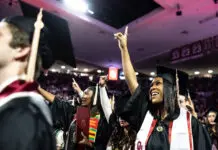While technical schools, like Meridian, can adapt quickly to address needs, the change is sometimes slower for public schools and some universities. University of Oklahoma’s Dean of the Business College Daniel Pullin, however, says that OU has a variety of ways it is working on solutions to these problems. One includes finding ways for quality teachers to get an education.
“Quality teachers represent one of the largest shortages of skilled workers in our state,” says Pullin. “Great teachers work to inspire Oklahoma’s next generation workforce as well.”

Through OU’s College of Education, students can take advantage of a Debt-Free Teachers program, which, Pullin says, provides “an inducement for Oklahoma-trained teaching talent to stay in the Sooner State in the years following graduation.”
The program allows OU students in the teacher certification program with a 3.0 GPA to receive funding if they teach in Oklahoma in a high need area after graduation.
In addition to teacher training, many programs are being developed around STEM (science-technology-engineering-math) skills. In Oklahoma, 6,700 STEM-related job openings are expected in the next 10 years, and not enough STEM students are graduating to fill those openings.
One way OSU is addressing this labor shortage is through its STEM Career Fair. “The fair is open to all students with majors related to science, technology, engineering and mathematics,” says Ehlers.
“This is a great opportunity for underclassmen who are considering a career in one of these majors to network with companies to learn more about STEM careers. Students will have an opportunity to visit with corporate recruiters about possible internships and summer employment opportunities, as well as full-time employment after graduation,” said Ehlers.
Area chambers of commerce also have much at stake where Oklahoma’s future workers are concerned. The Tulsa Regional Chamber launched an initiative called the Talent Dividend, which Reid said, is “a program exploring post-secondary attainment and the economic impact it has on cities.”
“In Tulsa,” Reid continues, “if we increased our college attainment rate by one percentage point it would have a $646 million impact on our economy annually. That’s economic development. This initiative shifted the mindset around focusing our efforts on creating a stronger talent pipeline to meet the needs of our businesses and community.”
Another project the Tulsa Chamber developed is the Road Trip for Teachers, a way to introduce teachers to the manufacturing industry. This program, Reid said, was designed to “dispel antiquated ideas about what types of jobs were available in manufacturing while also highlighting the wages, training and education required and the volume of jobs available.”
Promoting career awareness is also a major function of the state’s technical schools. At Meridian, Major said that career development specialists meet with middle and junior high school students “to help them begin to focus on their areas of interest.”
“Hopefully they can make the right choices in their course selections, which will lead them closer to their preferred career,” said Major.
Career awareness is one solution for Oklahoma’s workforce challenges, yet certain statistics continually highlight this pressing concern. In 2013, only 31 percent of Oklahoma eighth-graders were proficient in math, while 41 percent were proficient in reading.
These statistics drive some of the K-12 programs offered at the University of Oklahoma, including summer academies in architecture, aviation, chemistry, meteorology and engineering. In addition, OU has engaged K-12 students in its ExxonMobil Engineering Practice facility and the GEAR UP for Success program, which gives K-12 teachers interactive lessons in STEM education.
At the University of Tulsa, Earl Johnson, vice-president of enrollment and student services, says the university is meeting demands in the engineering and science fields in a variety of ways.
[pullquote]This connectivity between our students and Oklahoma role-models supports our efforts to grow and nurture our entrepreneurs from within, ensuring that the state is creating the high quality, knowledge-based jobs for our graduates,[/pullquote]“We have programming and extensive research opportunities for undergraduates in subjects such as biology, computer science and, specifically, cyber security where job opportunities are plentiful due to the unfortunate nature of attacks on infrastructure,” said Johnson. “Mechanical engineers with our undergraduate research and preparation are poised to tackle some of the most pressing issues facing industries such as automotive and manufacturing.”
In May 2015, Gov. Fallin said that Oklahoma had 68,000 job openings for skilled workers, and a few months later, secretary of education and workforce development Natalie Shirley upped that number to 85,000. Shirley has consistently described the need for trainable employees with knowledge in basic subjects.
Higher wages for teachers, which is what David Boren’s initiative focuses on, is one way to attract and retain quality teachers who develop quality students with that basic knowledge. Continually developing the most effective ways to teach students is also imperative.
According to Major, at Meridian, “We continually evaluate the length, content and delivery methods of instruction in an attempt to ensure that our instruction is relevant to employers and engaging to students. While our instruction has always been competency-based, today’s work environment requires more interaction and teamwork. To meet this need, much of our curriculum has become project-based in which students have to work together to solve real-world problems.”
Quality teacher training is necessary to provide students with basic knowledge and is increasingly needed to address the state’s growing diversity. According to Reid, in Tulsa, “Our shifting demographic is another game changer. Our fastest growing and youngest population is our Hispanic population. We need to embrace the diversity in our schools and learn more about the different cultures in our region and state.”
Reid highlighted the connection between inclusion and business development. “We need to invest in creating better ties and understanding of these cultures and show that we have an inclusive culture so we retain and attract talent to our region.”
At the University of Tulsa, Johnson says, “The most visible and meaningful change we have made is in the health care arena where combining the health-related programs into the Oxley College of Health Science has placed a deliberate focus on equipping students to serve the dire needs of our state, particularly in rural areas and some urban settings.”
A college degree increases the chance of workforce success, yet the biggest wage gap is for workers with skills certification and associate-level degrees. Because of this gap, many employers are finding they must change the way they attract, recruit and retain workers.
At OSU, Ehlers, says, “Employers are trying new ways to meet and interact with students.” For this purpose, OSU started Flip Fairs. “A Flip Fair is where student organizations set up a booth and the employment recruiters network with students to learn more about their organization, programs of study and ways they can proactively recruit students,” said Ehlers.
OU’s Sooner Promise program provides that link between STEM graduates and employers by keeping college affordable. Pullin said, “In addition to Sooner Promise, we are enhancing experiential learning programs through the implementation of new entrepreneurship and economic development offerings where students engage directly with industry mentors.
“This connectivity between our students and Oklahoma role-models supports our efforts to grow and nurture our entrepreneurs from within, ensuring that the state is creating the high quality, knowledge-based jobs for our graduates,” said Pullin.
Pullin points out that OU has identified key areas to attack directly: K-12 awareness and STEM emphasis, affordability and achievement, student success, internships, research and applied learning, career services and economic development.
Including all people in all types of education and training is perhaps the best way to fuel the talent pipeline and face, what Boren called, one of our state’s “greatest crises.”


























